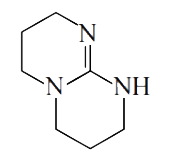Give the decreasing order of basic strength of the following :
(a) NH3
(b) NH2OH
( c) NH2−NH2.
To determine the decreasing order of basic strength of the compounds NH3 (ammonia), NH2OH (hydroxylamine), and NH2NH2 (hydrazine), we need to analyze the ability of each compound to donate a lone pair of electrons. Basic strength is influenced by the availability of lone pairs on the nitrogen atom and the presence of any electron-withdrawing or electron-donating groups.
1. Identify the Compounds and Their Structures:
- NH3 (Ammonia): Contains one nitrogen atom with one lone pair of electrons.
- NH2OH (Hydroxylamine): Contains one nitrogen atom with two hydrogen atoms and one hydroxyl (OH) group.
- NH2NH2 (Hydrazine): Contains two nitrogen atoms, each with one lone pair of electrons.
2. Evaluate Basic Strength:
- Basic strength is determined by the ability to donate a lone pair of electrons. The more available lone pairs, the stronger the base.
- NH3: Has one lone pair, making it a good base.
- NH2OH: The presence of the hydroxyl group (OH) exerts a -I (inductive) effect, which withdraws electron density from the nitrogen, reducing its ability to donate the lone pair. Thus, it is a weaker base compared to NH3.
- NH2NH2: Has two nitrogen atoms, each with one lone pair. This means it has a total of two lone pairs available for donation, making it a stronger base than NH3.
3. Rank the Compounds:
- Based on the analysis:
- NH2NH2 (Hydrazine) has the highest basic strength due to having two lone pairs.
- NH3 (Ammonia) comes next with one lone pair.
- NH2OH (Hydroxylamine) has the lowest basic strength due to the -I effect from the hydroxyl group.
4. Final Order:
- The decreasing order of basic strength is:
- NH2NH2 > NH3 > NH2OH
- NH3 (Ammonia): Contains one nitrogen atom with one lone pair of electrons.
- NH2OH (Hydroxylamine): Contains one nitrogen atom with two hydrogen atoms and one hydroxyl (OH) group.
- NH2NH2 (Hydrazine): Contains two nitrogen atoms, each with one lone pair of electrons.
- Basic strength is determined by the ability to donate a lone pair of electrons. The more available lone pairs, the stronger the base.
- NH3: Has one lone pair, making it a good base.
- NH2OH: The presence of the hydroxyl group (OH) exerts a -I (inductive) effect, which withdraws electron density from the nitrogen, reducing its ability to donate the lone pair. Thus, it is a weaker base compared to NH3.
- NH2NH2: Has two nitrogen atoms, each with one lone pair. This means it has a total of two lone pairs available for donation, making it a stronger base than NH3.
- Based on the analysis:
- NH2NH2 (Hydrazine) has the highest basic strength due to having two lone pairs.
- NH3 (Ammonia) comes next with one lone pair.
- NH2OH (Hydroxylamine) has the lowest basic strength due to the -I effect from the hydroxyl group.
- The decreasing order of basic strength is:
- NH2NH2 > NH3 > NH2OH
Topper's Solved these Questions
- GENERAL ORGANIC CHEMISTRYBOOK - CENGAGE CHEMISTRY ENGLISHCHAPTER - GENERAL ORGANIC CHEMISTRYEXERCISE - Concept
17 Videos
- GENERAL ORGANIC CHEMISTRYBOOK - CENGAGE CHEMISTRY ENGLISHCHAPTER - GENERAL ORGANIC CHEMISTRYEXERCISE - Comprehension
20 Videos
- GENERAL ORGANIC CHEMISTRYBOOK - CENGAGE CHEMISTRY ENGLISHCHAPTER - GENERAL ORGANIC CHEMISTRYEXERCISE - Solved Example
18 Videos
- CLASSIFICATION AND NOMENCLATURE OF ORGANIC COMPOUNDSBOOK - CENGAGE CHEMISTRY ENGLISHCHAPTER - CLASSIFICATION AND NOMENCLATURE OF ORGANIC COMPOUNDSEXERCISE - Analytical and Descriptive Type
3 Videos
- HYDROGEN, WATER AND HYDROGEN PEROXIDEBOOK - CENGAGE CHEMISTRY ENGLISHCHAPTER - HYDROGEN, WATER AND HYDROGEN PEROXIDEEXERCISE - Subjective Archive (Subjective)
3 Videos
Similar Questions
Knowledge Check
What is the decreasing order of strength of the bases ?
(I) OH−(II)NH−2
(III) H−C≡C− (IV) CH3CH−2AIV>II>III>IBIII>IV>II>ICI>II>III>IVDII>III>I>IV
The correct decreasing order of basic strength of the following species is _____________ .
H2O,NH3,OH−,NH−2
View SolutionArrange the following in the increasing order of their basic strength : (i)(CH3)3N(ii)CH3NH2(iii)NH3
View SolutionThe decreasing order of−I effect of the following is :
(I) CHO
(II) F
(III) OR
(IV) NH2
(V) OH
(VI) Ph.
View SolutionArrange the following in the decreasing order of their basic strength in aqueous solutions :
CH3CSNH2,(CH3)2NH,(CH3)3N and NH3
View SolutionArrange the following in the decreasing order of their basic strength :
i. PhNH2 ii.EtNH2 iii. Et2NH iv, NH3
View SolutionThe increasing order of PKb for the following compounds will be
(1) NH2−CH=NH,

(3) CH3NHCH3
View SolutionArrange the following in decreasing order of their basic strength :
C6H5NH2,C2H5NH2,(C2H5)2NH3
View Solution
